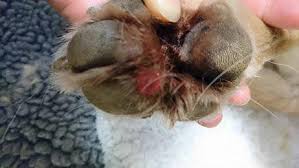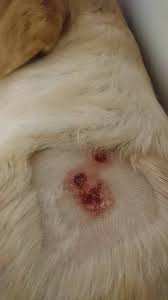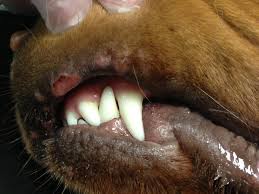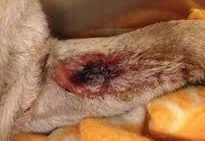Dog 1st Aid: Alabama Rot - CRGV
- Smile Dog Walking
- Jul 30, 2018
- 4 min read
What is CRGV?
Cutaneous and Renal Glomerular Vasculopathy, commonly known Alabama Rot or CRGV, is a deadly disease that has hounded Britain’s favourite pets since at least 2012. Dubbed by vets the “dog’s black death”, once CRGV strikes it is often already too late - with 70 to 80 percent of all cases being fatal and no known effective treatment.
Alabama Rot has been confirmed in more than 100 cases up and down the country since 2012 and campaigners are urging dog owners to keep their pets safe. The painful disease does not discriminate among targets and can strike anywhere in the UK. It affects dogs regardless of age, sex, wight or breed.
At least 29 cases of Alabama Rot have been confirmed across the country since the start of 2018, on top of 40 cases in 2017 and 19 in 2016. On March 20 The Anderson Moores Veterinary Specialists confirmed nine new cases of the deadly disease in Lincolnshire, Devon, West Sussex, Greater Manchester, Cornwall and London. The veterinary socialist said: “This brings the total number of confirmed cases to 152 since 2012, with 29 cases in 2018
The highest number of outbreaks appears to be concentrated in Dorset County, in New Forest National Park and surrounding areas. At least 15 dogs around the Greater Manchester area have also been infected, with reported cases as far out as Runcorn, Preston and even Leeds. Dogs have also been infected in Lincolnshire, outside of Middlesbrough and in the London boroughs of Harrow, Richmond and Wandsworth. So far only one case has been reported in Scotland, in Dumfries, but one case in Cumbria came dangerously close to the border.
Alabama rot causes skin lesions and can cause fatal kidney disease
The cause of Alabama rot is unknown, but most dogs that need treatment have been walked in muddy, woodland areas
If you notice symptoms of Alabama rot, such as lesions, sores or ulcers on your dog’s legs, paws or face, contact your vet immediately
How is it spread?
Right now it is unclear how the disease is spread but researchers are considering the possibility of environmental factors playing a part.
“Over the last 3 years, more CRGV cases have been seen between November and May than between June and October, suggesting a possible Winter and Spring seasonality.”
Some vets suspect the disease is contracted through contact with muddy and wooded areas, because most cases are diagnosed after owners took their dogs on outdoor walks. Other potential perpetrators are parasites, toxins and infected puddles.
What are the symptoms?
The most obvious signs are painful and bleeding lesions breaking out on the dogs skin. These circular wounds often appear on the lower leg, elbow or knee.
The Vets Now association warns: “The lesions may look like a swelling or ulcer. Dogs affected are likely to lick the wounded area and it will become hairless.
Lesions are likely to be followed by kidney failure, which is typically accompanied by vomiting, tiredness and lack of appetite. These signs can take up to 10 days to present.”
Once you suspect that your dog may have contracted CRGV, time is of the essence. In about 80 percent of all cases, once the disease spreads to the kidneys the dog will die within seven days. However, in cases where the kidneys remain unaffected the dog will stand a good chance of recovery.

How is it diagnosed?
Accurate and confirmed diagnosis is very difficult and sadly can often only be done with post-mortem samples. Biopsies can be taken from lesions on the feet/mouth but these on their own may not be conclusive. Animals can get Acute Renal Failure for much more common other reasons such as Toxins, Leptospirosis and bacterial infections and so these may need to be ruled out before CRGV (Alabama rot) is considered.
What is the prognosis?
Animals with the skin form only of CRGV tend to recover well with little or no problems. Animals that go on to develop Acute Renal Failure often need specialist treatment at a referral centre and even with this, the prognosis is very poor. Sadly most animals with kidney failure either die or are euthanased.
How can I stop my dog getting Alabama rot?
Unfortunately as the cause is still unknown, it is very hard to give specific advice on how to avoid it. There is little point in trying to avoid certain areas, as cases have been reported from all across the UK, there is no way of making sure you stay away from the cause. Also there is no pattern with types of countryside or location or climate.
It is common sense to avoid particularly water-logged areas
Make sure that you thoroughly wash any mud or debris from your dog after a walk
Check your dog’s body once a day for lumps and bumps would be a good habit for all dog owners to get in to
Sadly, dogs have contracted Alabama rot in many places across the UK over the past couple of years, with cases reported in Berkshire, Cornwall, County Durham, the New Forest, Nottinghamshire, Norfolk, Surrey, Wiltshire, Worcestershire and Northern Ireland.
Thankfully, the disease is not always fatal and the earlier it is caught, the greater your dog’s chances of survival. Dogs cannot be vaccinated against Alabama rot. If you are in doubt, give your vet a call. It’s better to be safe than sorry.








